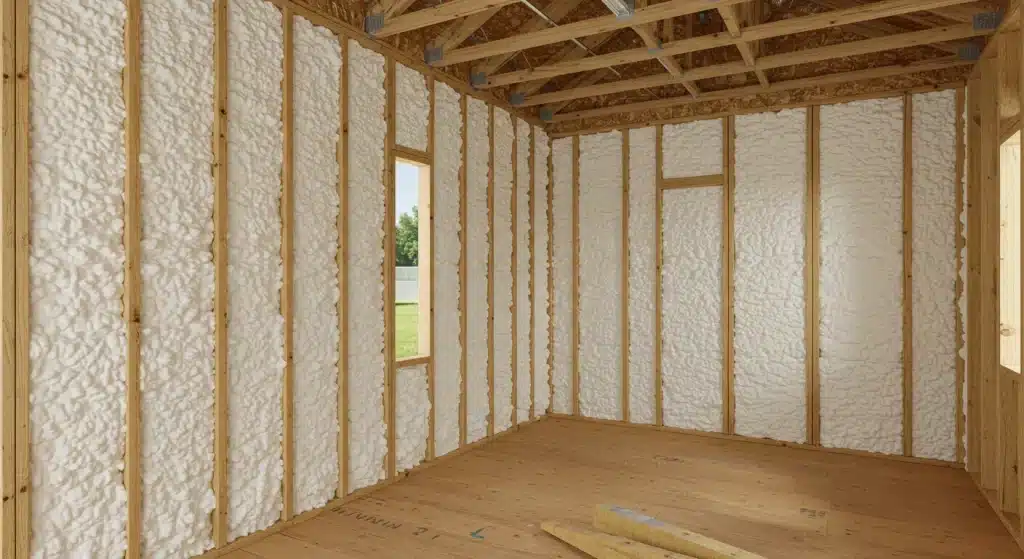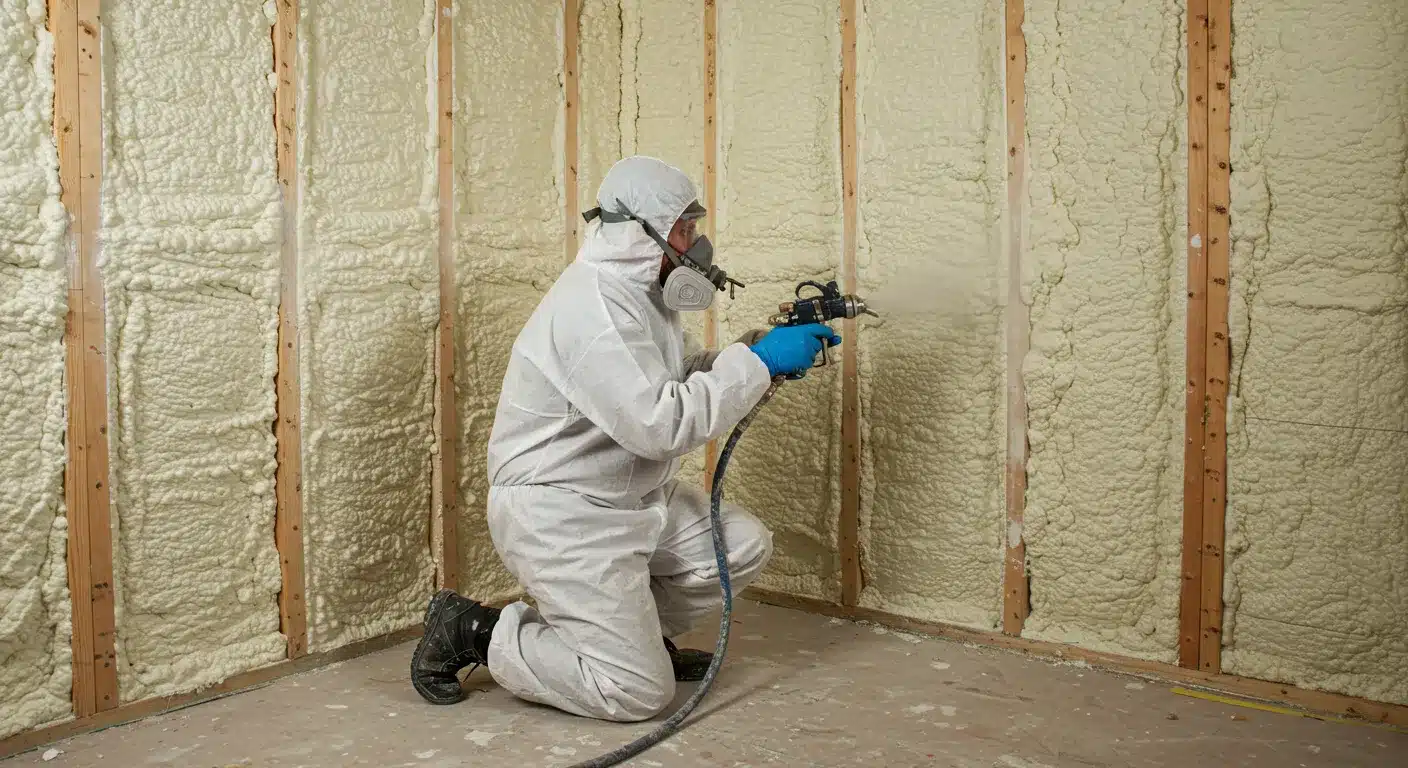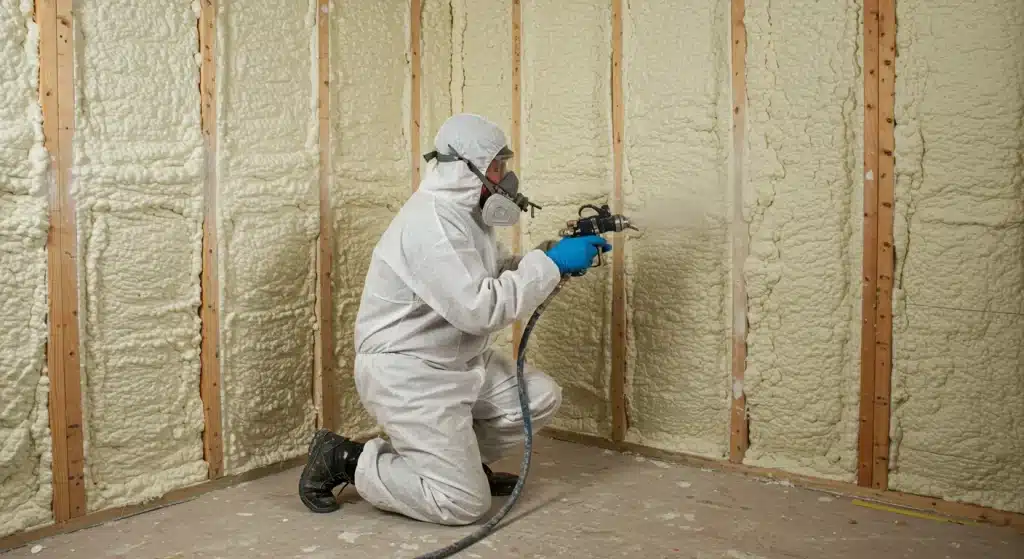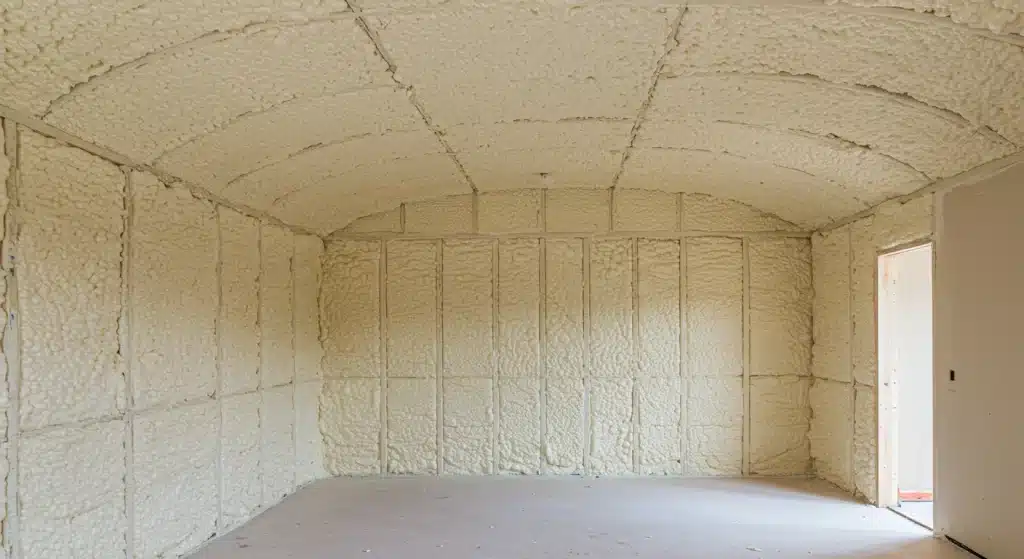When you think about home insulation, what comes to mind? For many, it’s itchy fiberglass batts or dusty blown-in cellulose. But modern building science has given us far more effective options, and at the forefront is spray polyurethane foam (SPF). It’s a game-changer for energy efficiency, comfort, and structural integrity. However, not all spray foam is created equal. There are two main types, open cell and closed cell, and choosing the right one for your project is absolutely essential.
This guide is designed to be your definitive resource on open cell spray foam. Drawing from years of hands-on experience insulating homes and commercial buildings, we’ll walk you through everything you need to know. We’ll break down what it is, how it works, and where it shines. Too often, homeowners and even builders are given incomplete information, leading to costly mistakes or missed opportunities. Our goal here is to give you the clarity and confidence to make the best decision for your property.
You’ll learn about the fundamental properties of open cell foam, from its spongy texture to its unique way of managing moisture. We will cover its powerful advantages in air sealing and soundproofing, explore the best places to use it (and where not to), and demystify concepts like R-value. By the end, you’ll understand not just the “what” but the “why” behind open cell spray foam’s performance.
What Exactly is Open Cell Spray Foam?
At a basic level, open cell spray foam is a type of insulation that is sprayed as a liquid and expands rapidly into a solid foam. The magic happens during the chemical reaction that creates millions of tiny bubbles. In open cell foam, these bubbles are not fully sealed; they are interconnected, creating a soft, flexible, and lightweight material.
Think of it like a sponge. The interconnected air pockets are what define its properties and differentiate it from its denser cousin, closed cell foam.
The Science Behind the Bubbles
Open cell foam is created by mixing two liquid components, an isocyanate and a polyol resin, which contains a blowing agent. When these liquids are combined at the tip of a spray gun, a chemical reaction starts instantly. The liquid expands up to 100 times its original volume in just a few seconds, filling every crack and crevice in the wall cavity or ceiling.
The blowing agent used in standard open cell foam is water. The reaction creates carbon dioxide, which fills the bubbles, or “cells.” Because these cells aren’t completely sealed, the foam remains permeable to vapor and has a flexible consistency once cured.
Key Physical Properties
Understanding these core characteristics is key to knowing where open cell foam works best.
- Density: It’s a very low-density product, typically around 0.5 pounds per cubic foot. This makes it light and requires less material to produce, which contributes to its lower cost.
- R-Value: Open cell foam generally provides an R-value of about R-3.5 to R-3.8 per inch. While this is lower than closed cell foam, its performance goes far beyond this number.
- Vapor Permeability: This is one of its most important features. Open cell foam is vapor-permeable, meaning it allows water vapor to pass through it. This helps building materials dry out if they get wet, preventing moisture from getting trapped, which can lead to mold and rot.
- Flexibility: Because of its low density and open cell structure, the cured foam is soft and flexible. It can accommodate the natural shrinking and swelling of a building’s structural members without cracking or pulling away.
How It Differs from Closed Cell Foam
Choosing between open and closed cell foam is one of the most critical decisions in an insulation project. They have fundamentally different properties and are suited for different applications.
| Feature | Open Cell Spray Foam | Closed Cell Spray Foam |
|---|---|---|
| Cell Structure | Cells are interconnected and not sealed | Cells are sealed, trapping a blowing agent |
| Density | Low density (approx. 0.5 lb/ft³) | High density (approx. 2.0 lb/ft³) |
| R-Value per Inch | ~ R-3.8 | ~ R-6.5 to R-7 |
| Vapor Permeability | Permeable (allows vapor to pass) | Impermeable (acts as a vapor barrier) |
| Air Barrier | Yes, excellent air barrier | Yes, excellent air barrier |
| Sound Dampening | Excellent | Good |
| Rigidity | Soft and flexible | Rigid and strong |
| Cost | Lower | Higher |
| Primary Blowing Agent | Water | High-R blowing agents (HFOs) |
Key Takeaways: Open Cell vs. Closed Cell
Open cell foam is a lower-density, vapor-permeable insulator that excels at air sealing and soundproofing at a lower cost. Closed cell foam is a high-density, vapor-impermeable product that offers a higher R-value per inch and adds structural rigidity, making it ideal for different applications where moisture control and thermal resistance are top priorities.
The Core Advantages of Choosing Open Cell Foam
While its R-value per inch may not be the highest on the market, open cell foam’s overall performance is driven by a combination of benefits that work together to create a comfortable and efficient building.
Superior Air Sealing Capabilities
This is arguably the single greatest benefit of open cell foam. Because it’s applied as a liquid and expands so dramatically, it flows into every gap, crack, and penetration in a building assembly. It creates a monolithic, airtight seal that is nearly impossible to achieve with traditional insulation like fiberglass batts, which can leave gaps around outlets, plumbing, and framing.
Why does this matter so much? Research from the U.S. Department of Energy suggests that air leakage through a building’s envelope can be responsible for 25% to 40% of the energy used for heating and cooling. By creating a superior air barrier, open cell foam drastically reduces this energy loss, leading to lower utility bills and improved comfort.
Excellent Sound Dampening
The soft, spongy texture and interconnected air pockets that define open cell foam also make it an exceptional sound absorber. The cells disrupt and absorb sound waves, significantly reducing the transmission of airborne noise between rooms and from the outside.
This makes it a fantastic choice for:
- Media rooms and home theaters
- Home offices and bedrooms
- Walls between bathrooms and living areas
- Floors to reduce noise from rooms above or below
While all insulation provides some sound reduction, open cell foam’s performance is noticeably better than most other common materials.
Expert Tip: If you’re building a home office or a nursery, using open cell foam in the interior walls is one of the most effective ways to create a truly quiet and private space. It’s a quality-of-life upgrade you’ll appreciate every day.
Moisture Permeability (A “Smart” Feature)
At first, letting water vapor pass through might sound like a downside, but it’s actually a sophisticated building science advantage. Buildings need to breathe. If a small leak occurs in the roof or plumbing, a vapor-impermeable insulation like closed cell foam can trap that moisture against the wood sheathing or framing. This trapped moisture can go undetected for years, leading to wood rot, mold, and serious structural damage.
Open cell foam, on the other hand, will allow the water to pass through. You might see a water spot on your drywall, alerting you to the problem early. More importantly, it allows the building materials to dry out once the leak is fixed. It doesn’t trap moisture; it allows the assembly to manage it, which is a much safer and more resilient approach for many parts of a building.
Cost-Effectiveness
Open cell spray foam generally has a lower installation cost than closed cell foam. This is for two main reasons:
- Less Material: Its low density means less chemical product is needed to fill a given space.
- Water-Blown: The blowing agent (water) is less expensive than the specialized agents used in high-R-value closed cell foams.
For projects where the primary goal is creating an excellent air seal and achieving good thermal performance in standard wall cavities or roof decks, open cell often provides the best value. The global spray foam insulation market continues to grow, with a projection from Fortune Business Insights expecting it to reach USD 2.95 billion by 2029, driven by demand for energy-efficient building solutions.
Common Applications and Best-Use Scenarios
Knowing where to use open cell foam is just as important as knowing its benefits. Its unique properties make it a perfect solution for some areas and a poor choice for others.
Interior Walls for Soundproofing
As mentioned, this is a prime application. For reducing noise transfer between rooms, open cell foam is one of the best options available. It completely fills the wall cavity, sealing all the small air gaps that sound loves to travel through.
Unvented (Conditioned) Attics and Roof Decks
One of the most popular uses for open cell foam is on the underside of the roof deck. This creates an unvented, or conditioned, attic space. By moving the building’s thermal and air barrier from the attic floor to the roofline, the attic and any HVAC equipment within it are brought inside the conditioned envelope of the home.
This has several benefits:
- It protects ductwork from extreme attic temperatures, improving HVAC efficiency.
- It creates a clean, semi-conditioned space for storage.
- It eliminates problems associated with attic ventilation, like wind-driven rain or ice dams in colder climates.
The vapor permeability of open cell foam is an advantage here, as it allows the roof sheathing to dry inwardly should any moisture get past the shingles.
Floors and Crawl Spaces (with Caution)
Open cell foam can be used between floor joists to insulate floors above unconditioned spaces like a garage or a vented crawl space. However, careful consideration is needed in crawl spaces. If the crawl space is prone to dampness or flooding, closed cell foam would be a better choice due to its moisture resistance.
Expert Tip: When insulating the underside of a floor, ensure all plumbing and wiring penetrations are sealed with the foam. This not only insulates but also stops drafts from coming up through the floorboards.
Where Not to Use Open Cell Foam
It’s critical to avoid using open cell foam in applications where it will be in direct contact with water or in situations requiring a true vapor barrier.
- Below Grade: Never use open cell foam on the exterior of a foundation or on the interior of a basement wall that is below ground level. It can absorb and hold water like a sponge.
- Exterior Applications: It is not designed to be exposed to the elements.
- Flood-Prone Areas: In any area that could experience flooding, closed cell foam is the only appropriate choice, as it is water-resistant.
- Tiny Homes and Vans: In applications where space is extremely limited and every inch of R-value counts, high-R-value closed cell foam is often preferred.
Understanding R-Value and Thermal Performance
Insulation performance is often boiled down to a single number: R-value. This number measures an insulation’s resistance to conductive heat flow. The higher the R-value, the greater the insulating power.
Open Cell Foam’s R-Value in Context
Open cell foam provides an R-value of approximately 3.8 per inch. A standard 2×4 wall cavity (3.5 inches deep) filled with open cell foam would yield an R-value of about R-13. A 2×6 wall (5.5 inches deep) would be around R-21.
Here’s how it compares to other common insulation types:
| Insulation Material | Typical R-Value per Inch |
|---|---|
| Open Cell SPF | R-3.8 |
| Closed Cell SPF | R-7.0 |
| Fiberglass Batts | R-3.1 to R-3.4 |
| Blown-In Cellulose | R-3.2 to R-3.8 |
| Rigid Foam Board (XPS) | R-5.0 |
While its R-value is comparable to or slightly better than traditional fibrous insulations, this number tells only part of the story.
Beyond R-Value: The Power of Air Sealing
The fatal flaw of materials like fiberglass is that they do nothing to stop air movement. A gust of wind can pass right through them, carrying your conditioned air with it. This is called convective heat loss.
Open cell spray foam stops this process entirely. By creating a near-perfect air seal, it eliminates heat loss from air leakage. According to the Building Performance Institute, this air barrier function is often more important for a building’s energy performance than a high R-value alone. An R-13 wall sealed perfectly with open cell foam will almost always outperform an R-13 wall insulated with leaky fiberglass batts.
This is why you can’t judge an insulation material on its R-value alone. You have to consider its ability to control all three forms of heat transfer: conductive (R-value), convective (air leakage), and radiant.
The Installation Process: What to Expect
Applying spray foam is not a DIY project. It involves complex chemical reactions and requires specialized equipment and extensive safety training. Hiring a qualified, experienced professional is non-negotiable.
Here’s a general overview of the process:
- Site Preparation: This is a messy job. The installation crew will spend significant time masking and covering everything that is not being insulated, including windows, floors, and fixtures. Proper ventilation of the work area is also set up.
- Application and Curing: The foam technician, wearing a full protective suit and fresh air respirator, sprays the liquid foam into the open cavities. It looks almost like paint at first, but immediately begins to expand. The foam is fully cured and stable within a few hours, though the area should remain well-ventilated for 24 hours.
- Trimming and Finishing: Open cell foam typically expands beyond the face of the wall studs. Once it has cured, the crew uses a special saw or blade to trim the excess foam flush with the framing. This creates a flat surface, ready for drywall to be installed.
- Safety Protocols: Professional installers follow strict safety guidelines from organizations like the Spray Polyurethane Foam Alliance (SPFA). This includes ensuring homeowners and other trades are not present in the building during and immediately after application to avoid exposure to chemical vapors.
Expert Tip: Ask your installer about their training and certification. Reputable companies will have technicians certified through programs like the SPFA’s Professional Certification Program. This ensures they are up-to-date on best practices for safety and application.

Frequently Asked Questions About Open Cell Spray Foam
Is open cell spray foam waterproof?
No, it is not. It is vapor-permeable and can absorb and hold liquid water if exposed to it directly. This is why it should not be used in below-grade or flood-prone applications.
Does it off-gas or have a smell?
During application and for a short period afterward (typically 24 hours), there are chemical vapors present. This is why the area must be vacated and ventilated. Once fully cured, modern spray foams are inert and stable, and they do not produce any significant off-gassing. Any lingering smell is usually gone within a day or two.
How long does open cell spray foam last?
When installed correctly and not exposed to UV light or physical damage, open cell spray foam will last for the life of the building. It does not sag, settle, or break down over time like some other insulation materials.
Can it be installed in an existing home?
Yes, but it’s more complex than in new construction. It can be installed in open cavities like attics or crawl spaces. For existing walls, the drywall must be removed to access the stud bays. This is often done as part of a larger renovation project.
Is it a good choice for my climate?
Open cell foam is an excellent choice for most climates, particularly in mixed or cooling-dominated regions. Its primary function as an air barrier is beneficial everywhere. In extremely cold climates (like Zone 6 or higher), some builders prefer the higher R-value of closed cell foam, but a properly designed wall assembly with open cell foam can perform very well.
Does it attract pests?
No. Open cell spray foam is an inert polymer. It has no nutritional value for insects or rodents. By sealing up the cracks and holes that pests use to enter a building, it actually helps to create a more pest-resistant structure.
Putting Your Knowledge into Action
You now have a deep understanding of open cell spray foam, from its spongy structure to its powerful performance as an air barrier and soundproofer. You know that it offers a unique combination of benefits: fantastic air sealing, excellent sound absorption, smart moisture permeability, and great value. You also know its limitations and the specific applications where it truly excels, like in attics, walls, and floors.
The most important thing to remember is that insulation is not just a product; it’s a system. The performance of open cell foam depends entirely on proper design and professional installation. When applied correctly, it can make a home dramatically more comfortable, quiet, and energy-efficient for decades to come. Use this guide as a reference as you plan your next building or renovation project.
Need Expert Guidance?
Choosing the right insulation can feel complicated, but it doesn’t have to be. If you have questions about whether open cell spray foam is the right solution for your project, it’s always best to consult with seasoned professionals. The team at Supreme Spray Foam LV has the expertise to assess your specific needs and recommend the most effective and efficient insulation strategy. For a professional consultation, you can contact us by email at [email protected] or give us a call at (702) 904-9895.
Sources
- U.S. Department of Energy – Offers data and guidance on the importance of air sealing for home energy efficiency.
- Fortune Business Insights – Market research report detailing the growth and projections for the spray foam insulation industry.
- Spray Polyurethane Foam Alliance (SPFA) – The official trade association for the spray foam industry, providing safety guidelines and best practices.






